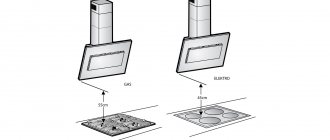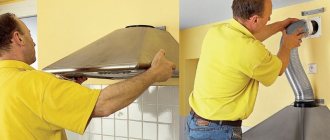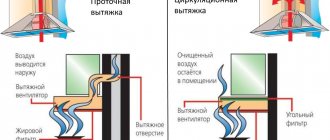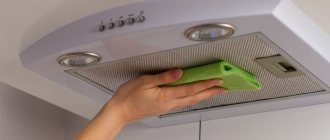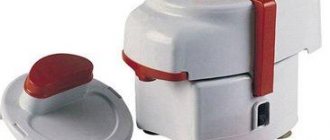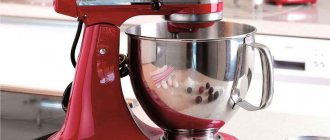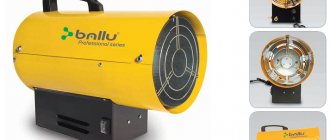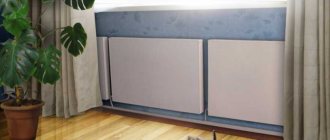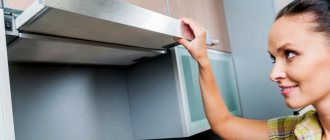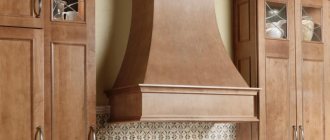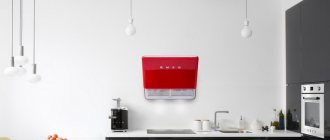Types of kitchen hoods
Exhaust devices are divided into several types according to their method of operation, design and mounting option. The type of device often determines the degree of its performance, so at the first stage of selection, it is worth remembering this pattern.
- Flow-through hoods are models equipped with a dome that remove polluted air into the general ventilation system through the chimney. Such hoods can have quite high power.
- Recirculation hoods are compact hoods, the operating principle of which is to pass air masses through a system of cleaning filters. These models, as a rule, have less power than flow-through ones; they pass a limited volume of air through them.
The rules for calculating performance for different types of hoods are slightly different. In a recirculation system, the main factor is the power of the motor, and in a flow-through system, the efficiency of air removal into the ventilation shaft.
Features of calculating the power of a kitchen hood
Let's summarize to answer the question of how to choose a kitchen hood based on power? To do this, you should take into account a number of factors that we have already noted above:
- Calculating the volume of air in the room.
- Find out the diameter of the air duct and its length.
- Having made adjustments in accordance with the presence of filtration systems and pipe bends.
- Noting the type of stove and the frequency of its use.
- Having determined a comfortable noise level.
Together, calculating the performance of a kitchen hood using these parameters will ensure that the appliance operates efficiently and economically. You can read about other features of choosing ventilation systems in special sections of our website.
Formula for calculating the performance of a recirculating hood
The standard calculation of the required performance of a kitchen hood is carried out using the following formula:
where: N - design capacity, m³/hour; S—kitchen area, m²; h – ceiling height, m; 12 - air exchange rate adopted by SES; 1.3—minimum reserve ratio.
Hood performance calculator
Kitchen area, m²: Ceiling height, m: Air exchange rate: Minimum reserve coefficient:
The universal formula allows you to calculate the parameters under the following assumptions:
- when using an electric stove;
- kitchen with closed doors and windows, separated from other rooms;
- The shape of the room is rectangular.
It is important to note that the calculation formula allows you to find out what volumes of air the device will process at maximum power and operating speed. Of course, in real conditions the device cannot constantly operate in the most energy-consuming mode. To obtain a more accurate result, it is recommended to add 15-20% to the final figure, this way you will calculate the performance of the kitchen hood for efficient operation in medium mode.
If a gas stove is used for cooking, then the coefficient of 12 should be changed to 20 without hesitation. In this case, in addition to fumes, ventilation will also have to remove gas combustion products from the kitchen. If the design has a carbon filter, it is worth adding 20 to 30%, since it creates additional resistance for the incoming air.
Necessary amendments when calculating
In most apartments, especially in older houses, kitchens are not large in size. Calculation of the required power will produce results in the range from 300 to 450 m3/h. Why do professionals recommend choosing hoods with a capacity of at least 600 m3/h?
- When choosing a hood according to the classical formula, the device will be forced to operate at maximum speed. This will not only affect the level of noise it produces, but will also greatly reduce its service life. In addition, if any unforeseen circumstances arise, there will be no more power reserve.
- The value of such a parameter as the air exchange rate depends on what type of hob is used. When using a gas stove, it increases to 20, because the hood will have to remove not only odors, fat and soot from the food being prepared, but also the combustion products of natural gas. If an electric stove is installed, then this coefficient will be slightly lower and amount to 15.
- The volume of the kitchen is easy to calculate. But many people overlook the fact that this room is not always separated from other rooms by tightly closing doors. In this case, the volume of the kitchen is added to the volume of adjacent rooms with which air exchange is not difficult. And this will require serious adjustments to the calculations made. The required performance of the device can increase significantly!
- According to the formula, for a small isolated kitchen a device of rather modest power is sufficient. In fact, in a tiny room, odors and soot will spread much faster. Therefore, in order to cook in such a kitchen in comfortable conditions, you should not skimp on the power of the appliance.
USEFUL INFORMATION: Corrugated hood: diameter, dimensions and installation
Table for calculating the minimum performance of a kitchen device:
Regardless of the chosen design of the hood, a mandatory condition must be met: its area should be at least as large as the hob, and better yet, slightly larger in size.
Calculation of the performance of a flow-through exhaust system
Calculation of the power of an exhaust hood with an air duct is also carried out by calculating the volume of air masses in the room. However, the performance of such a system is greatly influenced by the throughput of the duct. If the air exhaust duct is not installed correctly, the high-power appliance will not operate efficiently and may even fail. Frequent problems that arise are high noise levels and overheating of the electrical parts of the device.
In almost all apartment buildings, air ducts do not exceed 12–13 cm in diameter. Up to 400 m³ of air can be removed through them per hour. This figure should be taken into account when choosing a hood for the kitchen - if you buy a device with a higher performance, the power consumption will increase with a slight increase in productivity.
An important factor is the length and shape of the chimney pipe. If the exit to the ventilation shaft is too far from the installation site of the hood, and the channel itself has unevenness and angles, the air will pass through it at a lower speed. In this case, installing a powerful exhaust device is also unjustified.
Factors affecting power calculation
To calculate the performance of a kitchen hood, the formula is used:
Q=s × h × 12.
Here, only the size of the room, height to the ceiling and air exchange rate are taken into account. This is a correct calculation, but not complete.
In addition to the kitchen area, the following parameters must be taken into account:
- family composition (clean air consumption must meet sanitary standards per person);
- frequency of cooking;
- what dishes are prepared (with fatty broth or healthy food);
- cross-section, length, material of air ducts.
Slab type
Undoubtedly, the area and type of stove affects the performance of the hood. The type of stove affects the amount of waste in the form of scale and burning that gets into the air when frying meat, boiling borscht, or healthy food with only vegetables. At the same time, the flow of fresh air into the room also occurs in different ways. Consequently, the air exchange rate also changes.
Let's take a closer look at how this happens:
- The calculation of a kitchen hood in the presence of an electric stove differs from the classic one, since combustion products do not penetrate into the air, except for steam from cooking food. As a rule, the air exchange rate for these electric stoves is increased in calculations from 12 to 15, while the classic formula will also change as follows:
Q=S × H × 15.
- When a gas stove is used, the air exchange rate increases to 20. This is due to the fact that in addition to evaporation, combustion products in the form of burning, soot, scorch, etc. enter the air space above the stove. Here the formula for calculating productivity will be different: S × H × 20.
- It would be incorrect to state unequivocally that if there is a cooking surface with an area of 65 cm, the hood should be more productive than with a smaller stove of 55 cm. However, logically this can be assumed, because larger hoods process the air mass from a stove of a larger surface. It is simply impossible to completely remove all harmful particles and odors from cooking at low power.
It is important not to make mistakes when calculating device parameters. Calculating the power of a hood is much easier if you take into account the main aspects.
Kitchen location
When calculating the performance of a kitchen hood, the type, area and isolation of it are taken into account. This could be: an apartment in the form of a studio, a kitchen and living room at the same time, a separate kitchen. Also, sometimes an arch is installed in the opening instead of a door, or the door is constantly open, in which case these parameters must also be taken into account.
Here the kitchen, one way or another, is combined with the adjacent room, so the conditions for calculating the performance of the hood increase several times. Thus, when calculating the power of the device, you need to take into account these additional parameters in the adjacent room, thereby fully providing your household with fresh air.
There is an opinion among users that in a small kitchen a low-power hood is sufficient. But in a small room, odors dissipate faster, which means there is a greater amount of polluted air.
Accordingly, in order for the air to be clean, air exchange must occur more often. However, a low-power hood simply will not be able to provide this, or the engine will overheat and sooner or later burn out.
Power calculation
To calculate the performance of a hood, you first need to understand what functions the device should perform. According to the instructions, this device is supposed to purify or remove polluted air in the kitchen. According to sanitary standards, 12 air replacement cycles must take place within one hour. That is, he must change indoors 12 times in 1 hour. Now you know where the coefficient “12” comes from in formulas for calculating productivity.
The formula itself looks like this: Q=S*H*12, where:
- Q is the power of the unit, which is measured in m3/h;
- S – area of the room for which ventilation is needed;
- H – room height;
- 12 – coefficient indicating indoor air replacement cycles.
For example:
- room area - 12 m2;
- height – 2.7 m;
We substitute the values into the formula: Q=12*2.7*12=388.8 m3. Based on this calculation, the device will produce this volume only using maximum productivity. It will not withstand this mode for long and may fail.
To reduce the load, it is recommended to add about 15% to the calculated value.
This creates a small power reserve for the kitchen hood, making the appliance easier to operate. And you have the opportunity to turn on the maximum mode only during times of heavy smoke in the room, for example, on the eve of the holidays, when a large number of dishes are being prepared.
It should be noted that all these calculations for the volume of air exchange have average indicators, since various nuances are not taken into account:
- type of hob;
- hood type;
- room layout.
What types of kitchen hoods are there?
Before proceeding to calculate the required power of the hood, you should decide on its type. There are several varieties of these household appliances. The difference between them is not only in design, but also in the principle of operation. This can be either the removal of polluted air from the room or its recirculation after appropriate cleaning.
Dome
The polluted air, after entering the dome of such an exhaust hood, is thrown out by fans outside through a piping system.
Features of dome-type exhaust devices:
- The system requires a minimum of maintenance, but during its operation it requires an influx of fresh air into the room from outside.
- If the kitchen has modern double-glazed windows that do not allow air to pass through, then you may need to open the window while the hood is operating.
- The disadvantages of this system also include quite significant dimensions and complex installation.
- Such hoods are recommended for use in spacious rooms.
- The complex of boxes and corrugated connections must have a minimum of bends that impede the movement of air.
Flat
These hoods are more compact and easy to install. Unlike dome ones, they do not require connection to ventilation ducts, as they work on the principle of air recirculation.
Features of flat hoods:
- They don't take up much space in the kitchen.
- Require regular maintenance: carbon filters responsible for neutralizing odors will have to be changed every 3-6 months, depending on the intensity of cooking.
- Soot and grease are captured by replaceable acrylic or permanent metal filters. The former will also have to be changed regularly, and the latter washed with detergents.
Built-in
It is better to buy built-in models at the stage of planning the overall kitchen interior. For them, you will have to select or specially order furniture in which most of the hood will be placed.
Features of built-in hoods:
- In their design, they are very similar to dome ones, but, as a rule, they are distinguished by greater power and lower noise levels.
- Most of their design will be hidden inside the furniture, so you won’t have to rack your brains about how to harmoniously fit such a hood into the overall composition of the kitchen.
Note! Even powerful dome and built-in hoods will not be able to provide more air exchange than the capacity of the apartment’s ventilation duct.
In most houses, ventilation ducts can provide unimpeded passage of no more than 180 m3 per hour. Therefore, it is preferable to use hoods that operate on the principle of air recirculation or mixed-type devices. Their higher cost is compensated by their independence from the ventilation capacity of the apartment. Also, there will be no need to solve the problem of fresh air entering the room.
How to choose a kitchen hood: we help you decide on the criteria
Choosing a kitchen hood is a fairly simple task, especially if you familiarize yourself with the main characteristics of this device in advance (of which, it must be said, there are not so many).
But first, let's say a few words about why a hood is needed at all and what functions it performs. The main task of the hood is forced ventilation and air purification, which inevitably becomes polluted in the kitchen. These include grease splashes, sediment from burnt impurities present in household gas, and ordinary tobacco smoke. The easiest way to clean such air is to simply remove it from the room. A more complex method is to filter the air and return it back purified.
Thus, we have determined the first parameter by which you need to choose a hood: will it remove polluted air or return it back to the kitchen?
Hood: recirculation or direct-flow?
In most cases, where it is possible to install a direct-flow hood, it is better to choose it: removing polluted air will clean the room from extraneous odors better than filtration. The straight-through hood can be installed anywhere. The only condition is that there is a nearby ventilation system to which it can be connected. It is not recommended to pull the air duct over long distances: not only will it not look very aesthetically pleasing, but it will also lead to a decrease in the efficiency of the hood (it is believed that each 90-degree turn reduces the efficiency of the hood by 5%).
A direct-flow hood has a coarse metal grease filter, which is designed to prevent grease from settling on the inside of the device - the motor elements and the housing. After all, this can not only lead to engine failure, but will also become a source of unpleasant odor over time. This filter is usually removable. It can be washed and works for the entire service life of the hood. However, experience shows that it is often not so easy to wash it, and sooner or later the user is faced with the need to replace the filter.
A recirculating hood usually has two filters: one of them, again, serves to remove oil particles (as a rule, it is made in the form of a plastic cassette, which must be replaced after a certain level of contamination). The second filter is a carbon filter, it serves to eliminate unpleasant odors. The carbon filter is also disposable and therefore must be replaced regularly. It’s easy to guess that the cost of such “consumables” can amount to a significant amount (it is recommended to change the carbon filter, for example, every 4-6 months). Especially if there is a lot of cooking in the house and often.
The Gefest VO 10 K45 hood can operate in both recirculation and direct-flow modes
Many hoods provide an alarm to indicate the need to replace the carbon filter or maintain the metal grease filter. This could be, for example, a light indication on the control panel. A simpler option is special symbols on the filter that disappear as it gets dirty.
Therefore, a recirculation hood is recommended for installation where it is not possible to install a direct-flow hood: in the absence of access to the ventilation shaft or where the installation of an air duct is not suitable for aesthetic reasons (for example, above a kitchen “island”). We also note that the operation of recirculating hoods does not lead to a decrease in the temperature in the room (this may be important, for example, in country houses).
Direct-flow hoods often allow operation in recirculation mode: in this case, they will have to purchase an additional filter, which is usually not included.
But it’s better not to look at budget direct-flow hoods that do not have any filter elements: of course, they will cope with the removal of polluted air, but soon they themselves will become so dirty that it will be quite difficult to wash them.
Hood power
The volume of air that it can remove (or purify) per unit of time depends on the power of the hood. The calculation will be simple: according to sanitary standards, the hood must extract at least 10-12 m³/h. We calculate the volume of the kitchen space, multiply by 12, add a “reserve” of 20 percent and another 5%-10% if the kitchen uses gas rather than electricity - and we get what we are looking for. If you want to save money, you can subtract the volume occupied by furniture and a refrigerator.
For example, a kitchen with an area of 10 square meters and a ceiling height of 3.2 meters will require a hood with a capacity of about 500 m³/h.
Most hoods have several operating modes, which allows you to regulate the speed of the motor, and at the same time the volume of air passing through the device (and at the same time the noise level).
Noise level
The noise level produced by the hood can cause some inconvenience. Therefore, it is better to be able to “listen” to the hood in a store (however, it’s easy to make a mistake here, because the level of background noise in a sales area will be significantly higher, and the dimensions of store premises are very different from the dimensions of a home kitchen).
A normally operating dome hood produces a noise level of 50 decibels. It can be compared to a quiet conversation at a distance of 3 meters. If the hood you choose is louder, you should seriously think about the feasibility of such a purchase.
Hood dimensions and installation methods
Based on the method of fastening, hoods are divided into several types:
- Hanging: such hoods are attached to the bottom plane of a wall cabinet or kitchen shelf. They usually have a flat and rectangular shape and small dimensions. They are easy to install, but due to their small size, the filters in such hoods will have to be changed more often.
- Built-in: such hoods are mounted inside kitchen hanging furniture, so they can be completely hidden from human eyes. Built-in hoods can most often be found in small kitchens - where you have to save space.
- The fireplace or dome hood is well known to everyone: it is the one that can most often be seen in city apartments, especially where they cook a lot and often.
- A wall-mounted hood is attached to the wall directly above the stove.
- An island hood, on the contrary, is designed for installation on the ceiling, above the stove located in the area of the kitchen “island” located in the center of the room.
- We also note the rarer corner hoods (intended for installation in the corner of a room) and telescopic hoods, with a retractable air intake element (such hoods are installed in a wall cabinet, but are characterized by extremely low power).
- The latest fashion trend is retractable hoods built into the countertop. Such devices will cost significantly more than traditional hoods, but they will allow you to completely hide the device under the countertop (thereby freeing up space above the stove). More modern than this are perhaps hoods built directly into the hob.
The built-in hood Box Plus LED FBI 737 XS LED can easily be hidden inside the kitchen furniture.
The dimensions of the hood should be selected based on the dimensions of the hob and common sense: in general, it is believed that the width of the hood should be no less than the hob (more is possible). Ideally, the length and width of the hood should match the corresponding dimensions of the stove or hob. This will not only ensure optimal operation of the device, but will also look the most aesthetically pleasing. Today, manufacturers produce hoods with widths from 45 to 90 cm. The most popular are models with body widths of 50, 60 and 90 cm.
Sirius SIL24TCB island hood can be installed directly above the hob
Case design and material
The choice of the appearance of the hood is determined by two factors: the attractiveness of the design and ease of maintenance (everyday cleaning). There are many models on the market, so there is no doubt that every cook will be able to choose just the right hood that will look great in his kitchen. But cleaning can be difficult. Therefore, it is better not to choose hoods whose body is made of cheap heat-resistant plastic, and opt for enameled, or better yet, metal bodies, which will be more durable and easier to clean. The alternative in the form of tempered glass is visually attractive, but it is an expensive solution and not very convenient for everyday care.
Design solutions, such as the Smeg KC90AO, can look quite unusual
Control
The hood control can be mechanical or electronic (for example, touch). In the first case, switching operating modes and lighting systems is carried out using mechanical buttons, in the second - using an electronic system, often equipped with a display indicating the selected operating mode.
The main advantages of the electronic control system (in addition to aesthetic ones) are the ability to set a timer for turning the hood on and off. More advanced models can automatically change their mode depending on the degree of air pollution, and some even allow remote control via a special remote control or smartphone. The need for the presence or absence of such functions remains at the discretion of the buyer.
Additional (optional) modes include an intensive mode, in which the hood operates at maximum power for some time, after which it switches to one of the standard modes, and an interval mode, which involves periodically turning on the hood for a predetermined time.
The controls for most hoods remain standard - understandable even to an inexperienced user
The lighting provided in most hoods will help illuminate the hob and can also become an independent element of the interior. Most hoods use standard E14 bulbs, but due to the latest EU energy saving directives, all hoods will be switching to more energy efficient LED bulbs in the near future. If desired, you can choose a hood that allows you to adjust the light intensity or even allow directional lighting of a specific kitchen area.
It is also worth mentioning hoods that are ready to work together with hobs. Naturally, compatibility here remains at the manufacturer level: it must be the same. Such hoods are, in fact, controlled by the hob itself: it decides which mode will be optimal at the moment, based on the use of its resources.
Installation features
Concluding the conversation about hoods, it would not be superfluous to remind you not only about the need for proper installation of this simple device, but also about organizing the correct ventilation system in a living room. After all, there are many more pitfalls here than one might imagine at first glance. The most obvious one is probably familiar to many: after installing double-glazed windows in the apartment, the air flow is disrupted, the air in the room becomes too dry, and there is little oxygen. You also need to remember about a sufficient inflow when installing a hood: after all, if enough air does not get into the apartment, then it will be more difficult to “pump” it out.
The second point is the installation height of the hood relative to the hob. Recommended values are less than 75 cm for a gas stove and 65 cm for an electric stove. If the hood above the stove is located high, it is better to choose a model with a wider air intake surface than the hob.
We have already mentioned power losses associated with too long or winding air ducts, but many continue to forget about the need to ensure natural ventilation to this day. During the installation of the hood, the original ventilation hole is often blocked, as a result of which the air from the kitchen stops flowing naturally. As a result, the hood has to be turned on much more often - just to “ventilate” the room.
The simplest way to connect the hood to the ventilation system is a flexible silver corrugated pipe. However, it does not look very aesthetically pleasing and, in addition, can make noise during operation. The solution is a rigid air duct made of metal or plastic pipes.
Before installation, it would be a good idea to check all dimensions and mark the surface for installation: these instructions can be found in the instructions for the hood.
The easiest thing to install a hood is connecting to the electrical network. Most dome models allow you to “hide” the wire under a decorative box (part of the air duct will also be hidden under it). This solution will require an outlet or at least a wire located in the upper part of the kitchen (under the ceiling). It is clear that it is better to think about this in advance - at the kitchen design stage.
conclusions
Let us list once again the steps to be taken when choosing a home hood:
- First, you need to decide on the type of hood: will it remove contaminated air (direct-flow) or clean it and feed it back into the room (recirculation).
- The power of the hood directly depends on the size of the room in which it will be installed. To select the appropriate power, just use a simple calculation formula.
- The method of installing the hood determines not only its appearance, but also whether it is suitable in principle for solving your problems: for a kitchen “island” one type of hood is used, for an open space - another, for embedding in a kitchen set - a third.
- How “independent” the device will be depends on how “advanced” the hood control system is. If you are ready to turn the hood on and off manually, a mechanical control will do. If you want the hood to turn on and off according to a timer or schedule, you cannot do without an electronic control system.
- Not only the appearance of the hood, but also how convenient it will be to clean it from dirt depends on the material of the body. Different types of coatings will require different care and different cleaning products.
How to choose a kitchen hood based on power
External data and additional elements are not the main indicators. In the first place are technical data and volumes of purified air. The hood productivity is calculated in cubic meters/hour, and the power consumption is calculated in kilowatts spent on operating the device. In an hour, the equipment must refresh all the air in the room at least ten times.
The power of the hood depends on its performance. The more powerful the fan, the more air the hood will push through. Traditional power calculations are designed for circulation models. The productivity formula is simple.
You need to multiply the kitchen area by the ceiling height and by a factor of 12. If a gas stove is installed in the house, then the factor is changed to 20. The last figure is the sanitary standard for absorbed cubic meters of air in residential buildings. 20% of the power reserve is added to the finished value.
This formula will calculate ideal conditions for:
- kitchens with small electric stoves;
- closed premises;
- small rectangular room.
If there is an arched opening in the room or the door is always open, then calculations are made based on the area of the corridors.
Devices with an exhaust system require calculation of the air duct cross-section. In panel apartments, the cross-section of the ventilation ducts is 12.5 cm. This is enough to move about 400 cubic meters of air. A hood with a higher capacity will not cope with its task.
High-power equipment has a significant drawback: high noise levels. Most models are equipped with asynchronous electric motors, which are quieter than other household appliances. But if you turn on the hood at full power, the noise will cause discomfort. In a house where there are small children, it is better to install a quiet device. Inclined models have low noise levels and high power.
What affects the minimum required performance of the device?
When choosing an exhaust device with minimum performance, many factors are taken into account, such as the type of hob, the layout of the kitchen space and the location of the air duct.
Hob
To adjust the formula, depending on the type of hob, certain coefficients are used:
- For electric stoves the indicator is set to 1.5.
- When calculating the exhaust power for a gas surface, a coefficient of 2.0 is used. The indicator is due to the presence in the air of not only food vapors, but also gas combustion products.
Thus, the minimum equipment capacity for a kitchen of 12 m² and a ceiling height of 2.7 m with an electric stove is 486 m³/h, and with a gas stove - 648 m³/h. To comfortably use the device in medium performance modes, the kitchen hood should have a capacity in the range of 600-800 m³/h.
It should have dimensions equal to the dimensions of the hob. It is better to choose a device with large widths.
Exhaust system type
If the air ducts are connected to the ventilation duct of the apartment, natural air exchange can be disrupted. A hood placed above the stove will not be able to remove polluted air that accumulates near the ceiling.
When choosing a recirculation system, the performance of the device is of particular importance, because the air does not leave the kitchen, but returns to the room. The pressure of air masses increases when passing through filters, which reduces the performance of the device.
Each rotation of the ventilation duct reduces the system power by 10%. Taking into account the presence of filters in the recirculation system, 30% is added to the calculated capacity of the hood. Even considering the ease of installation of such a system, many apartment owners prefer the option with a tap.
Important! When connecting the hood to the air duct, add a power reserve factor of 1.3. If carbon filters are installed, it increases to 1.7.
When operating the device in exhaust mode, take into account the throughput of the air duct. You can increase the volume of pumped air by increasing the power, but the noise will increase and the electric motor will begin to overheat.
The standard ventilation duct has a diameter of 125 mm. 400 m³/h easily passes through it. In this case, a powerful hood will be ineffective. When calculating the power of equipment for a small kitchen in a simplified manner, you should pay attention to a low-power device. However, for a very small room (9 sq. m.) you will have to choose a model more powerful than the calculated one. This is due to the fact that small rooms are filled with odors faster.
Features of the kitchen layout
When choosing kitchen equipment, pay special attention to the area of the isolated room. It should be limited by doors, windows and walls. If the door to the kitchen does not close, or the room is combined with the living room, the indicators of the adjacent room are added to calculate the area. The result is a larger number, for example, 20 square meters. m.
Since cooking odors spread quickly, the performance requirements of a kitchen hood increase dramatically when multiple rooms are combined.
Dependence of noise level on performance
As power increases, the noise level of the operating system also increases. If it is too high, the person in the kitchen gets tired quickly, which leads to a deterioration in his condition and the quality of the food.
Modern equipment produces noise in the range of 40-45 dB. In household hoods, asynchronous motors are installed, which are much quieter than many vacuum cleaners and drills. However, the sound of the device begins to cause discomfort when the performance mode is increased.
The best option is to purchase a hood with adjustable power. It will not be possible to find a completely silent device, despite the efforts of the developers of modern climate control technology.
Important! To reduce operating noise of exhaust equipment, it is regularly serviced. Filters and air ducts require timely cleaning.
To remove odors from the kitchen, exhaust equipment with optimal power is selected. They take into account the area of the room, the type of stove, and the features of the ventilation system. It is important to consider the main factors so as not to buy a more powerful but ineffective device.
Nuances of calculating kitchen hoods
The above formula is basic and does not reflect some of the features of a particular kitchen.
The amount of harmful emissions depends not only on the method of cooking (frying, boiling), but also on the type of cooking surface. Consequently, the frequency of air exchange will be different. If, for example, for a kitchen with an electric stove, taking into account force majeure, a 15-fold air exchange will be sufficient, then a 20-fold air exchange is necessary for a gas stove (after all, gas combustion products are added to the fumes from cooking).
The hood above the gas stove should be more powerful
The calculated performance assumes constant operation of the hood at maximum speed. This means that you will be accompanied by constant noise from the fan while cooking. Agree that this is quite tedious. Therefore, it is wiser to purchase a hood with a good safety factor. For a standard kitchen of 12 square meters. m and a height of 2.5 meters, a device with a capacity of:
— 486 m3/h – with electric stove;
— 648 m3/h – with a gas stove.
Based on the above information, the conclusion suggests itself: the basic calculation formula will give you an idea of the minimum permissible hood performance for your kitchen. If you like a device whose power is less than the calculated one, don’t take it: it will be just a useless trinket, and not a working unit.
- Many sellers, with the confidence of experienced specialists, advise owners of small kitchens to purchase the most primitive hoods with low performance. This is a misconception: in a small room the concentration of harmful fumes is much higher than in a spacious kitchen, therefore the device must have good performance.
- The exhaust system is not a complete replacement for the ventilation system. Its purpose is to remove contaminated air in the hob area.
- No matter how high-performance the hood is, its power drops in an unequal struggle with the throughput of the ventilation duct to which the air duct is connected. In our apartments, the ventilation duct can pass no more than 180 m3/h. Its cross-sectional size is only 130x130 mm. You can buy a powerful hood with 1.5 thousand cubic meters, but its effect will depend on the cross-section of the channel. Anything he doesn't miss can be considered a loss. Therefore, the best solution is to buy a recirculating hood.
Types of hoods for the kitchen
The most powerful kitchen hoods
Calculations of the optimal extraction power were given above. Now we present the top 5 most powerful models of 2021.
MAUNFELD URANIA 53
The UK company has developed one of the highest quality premium models that has many advantages over competitors' products. At the same time, it will not spoil the look of the kitchen, since it is completely built into it. Despite this, operating the device is very simple and does not cause any inconvenience.
Electronic control is organized using buttons and a display. In addition, you can switch the operating modes of the hood remotely, because it is equipped with a remote control.
As for power, in terms of this parameter Urania is considered one of the best. With a width of only 60 cm, it is capable of purifying up to 1250 cubic meters of air per hour.
It is also worth noting other advantages of the model: the presence of LED backlighting, a timer and four speed modes of operation. In addition, the new model received a perimeter suction system and an automatic ventilation function.
Kuppersberg F660
A fireplace-type kitchen hood, which, while not too expensive, boasts good performance. 900 cubic meters of purified air per hour puts it at a level above other competitors. Working with the model is very convenient. It has simple and intuitive touch controls that make it easy to adjust the operation of the device. You can adjust the hood to suit any conditions - it has five operating speeds.
Other advantages of the model are excellent design, low noise level during operation and the presence of a remote control. In addition, you can set a timer, thanks to which the device will turn on and off automatically.
Elica SPOT PLUS ISLAND IX/A/90
Quite a powerful hood, which at the same time has excellent functionality. The power of the model allows it to purify about 1200 cubic meters of air per hour. The device body is made in a minimalist style. The hood has a timer and an indicator showing the level of filter contamination. It is also worth noting the presence of an anti-return valve and pleasant lighting. Thanks to the presence of a small screen and touch panel, it is very easy to control the functions of the hood. Settings can be selected for a specific user.
It is important to pay attention to the presence of an intensive regime. It can be used to eliminate particularly strong odors that may arise when frying fish. When this option is enabled, the hood quickly purifies polluted air and then returns to standard operation.
Apart from the relatively high cost, it is difficult to note any other disadvantages of the hood. A high noise level is expected at such power.
Weissgauff Aura 1200 Remote BL
A powerful hood, in the development of which almost all modern technologies were used. It is capable of purifying 1200 cubic meters of air per hour. The model is completely built-in, so it will not take up much space in the kitchen and will fit into any design. Among the advantages, it is worth highlighting convenient touch controls and the presence of a remote control. In addition, the hood has the following advantages:
- perimeter suction system;
- efficiency – can work in very large rooms;
- digital display with large display;
- three speed modes and an automatic shutdown timer.
The hood can also operate in recirculation mode. To do this, you need to additionally purchase special carbon filters. The main disadvantage is the rather high noise level, but, as in the case of the previous model, this is due to its power.
Jetair Lilly 60 IX
A fireplace hood with a modern, pleasant design. It is suitable for a large kitchen, as it is capable of purifying up to 1200 cubic meters of air per hour.
In addition, the model has a large number of advantages: the presence of an anti-return valve and a filter contamination indicator, the ability to operate in drainage and recirculation modes. A convenient display and push-button controls allow you to work with the hood as comfortably as possible.
The model has three speed modes that can be configured for specific purposes. The main disadvantages are high noise levels and power consumption.
ELIKOR Onyx 60
The quiet inclined hood has an original appearance. The high level of performance allows you to absorb even the most pungent odors. It has four modes, the highest of which removes polluted air in a matter of minutes. The aluminum filter traps soot and grease. The workplace will be illuminated by two bright lamps. The touch buttons are protected by glass, which ensures flawless gear shifting. The noise level in turbo mode is 59 dB. The 15-minute timer absorbs residual odors after the hob has finished operating.
Faber GLASSY ISOLA/SP EG8 X/V A90
The most powerful island hood on the list. Completely eliminates combustion products, fat and soot. The built-in diffuser suppresses noise and ensures efficiency even with problematic ductwork. It is possible to install additional cleaning filters. The model provides 3 speed modes. The maximum noise level is 68 dB. The design allows the hood to fit harmoniously into any interior. Halogen lamps illuminate the hob. The glass surface can be used as a shelf for necessary things.
Correct calculation of kitchen hood performance
When there is a desire or need to carry out a more detailed, accurate and correct calculation, it is necessary to use this method. It is, of course, labor-intensive and will take more time than the first example, but as a result you will have the most accurate indicator of the required hood performance.
This result will allow you to find a rational approach to choosing the power and performance of a kitchen hood, and will also make all elements of the exhaust system work as efficiently as possible.
So, let's begin.
Heat from the stove
The first step is to determine the amount of heat that comes from the stove. This takes into account the type of stove: gas or electric. Calculation of heat transfer from the stove is carried out taking into account its operation at maximum.
Our task is to find a technical data sheet for the kitchen stove, where its characteristics are indicated. For example, let's take the Greta gas stove:
Characteristics of the Greta gas stove
The total thermal power of the gas stove is Q = 1.7+2.25+0.95+1.7+2.4 = 9 kW (9000W). As you can see, the power of all four burners plus the power of the oven burner is taken into account, although you can take into account 3 burners turned on at the same time.
By the way, as you can see, we accepted the heat dissipation from the stove with a very large margin. So, as we take into account the heat from the burners, in fact, the heat is transferred to the dishes, while the efficiency of modern burners is about 75-85%. That is, of these 9000 W on the burners, 85% will be transferred to the dishes, and already those 15% of the heat released into the air + heat from the heated dishes are transferred to the room - approximately 1000...1500 W. A total of 1800...3000 W should be eliminated by the kitchen hood.
In this case, the amount of heat to be removed will be equal to
Q = 9000*0.15+1500 = 2850 W.
Equivalent diameter and speed at the suction axis
Next, we find the equivalent diameter of the kitchen stove. So, since the slab is square, then where a, b are the length and width of the slab.
For our example
After this, you need to find the speed on the suction axis of the hood.
where l is the distance from the surface of the stove to the exhaust hood (kitchen hood).
After reading the article on how to install hoods , you will learn the recommended distance that should be taken depending on the type of cooker. We take the value 0.8 m. Then, the axial speed will be equal to
Let's continue further.
Basic performance
The basic amount of air removed by a kitchen hood is determined by the formula, m3/hFor our case
The basic capacity is 2080 m3. at one o'clock.
Full kitchen hood performance
The full performance of a kitchen hood is determined by the formula, m3/h
where kt is a coefficient that takes into account toxicity (equal to 1, but since we need to remove moisture, grease and smoke in addition to heat, we take it equal to 1.1), kv is a coefficient that takes into account the movement of air near the stove (we take 1.5), kn is a coefficient that takes into account the geometric features of the stove (equal to 1). So, the total productivity of the kitchen hood is equal to
As a result of this calculation, we found out the required productivity of the kitchen hood, which was 706 m3/h.
As you can see from the calculations, the performance indicator was relatively average. In this case, the calculation was performed based on the maximum power of the stove - with four burners and the oven turned on at full power, which is practically not carried out.
Selection of kitchen hood
For example, you can choose to install a kitchen hood ELEYUS Titan A 750 60 BL for 750 m3/h. Its price is 5,700 rubles.
Design Tips
1. Do you want the main emphasis in the interior to be on facades and furniture? It would be more correct to choose a built-in kitchen cabinet for a hood or a wall-mounted direct hood. 2. Built-in invisible models and detailed dome designs are suitable for traditional-style interiors.
3. Modern kitchen style is characterized by clear and simple forms and laconic design. Built-in, wall and ceiling types of hoods without additional elements are suitable.
4. The color can be chosen to match the shade of the rest of the kitchen appliances (for example: chrome, white or black).
5. The choice of hood can also be influenced by the surface of your kitchen facades. Based on this, it can be glossy or matte.
